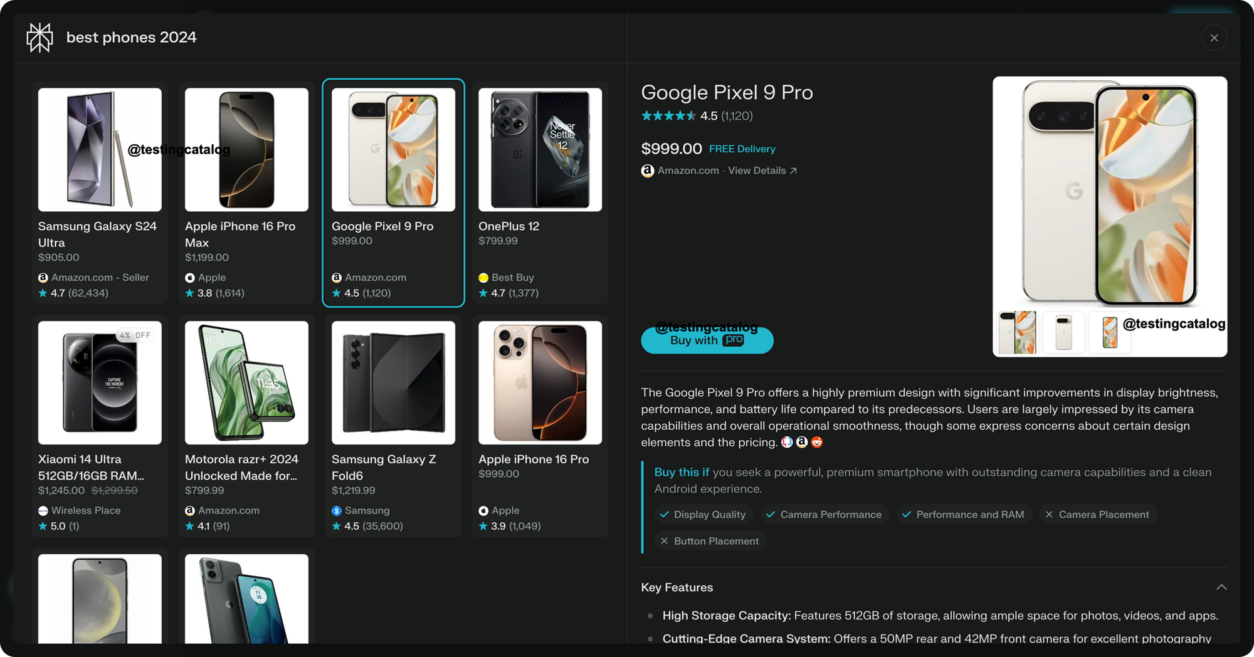How Agentic AI is Redefining Ecommerce

Agents hold the key to customer experience
The current online shopping experience is much the same as it has been for decades: wildly convenient for those who jump in knowing what they need to buy, and crummy for those who are uncertain and are looking to shop.
Agentic AI offers a step change in the quality of customer experience that retailers and brands can bring to their customers. By understanding a customer’s behavior and preferences, and being empowered to act on behalf of that customer, agentic AI can replicate many of the best qualities of a top-notch instore sales associate. It can help engage customers, move them more easily through the funnel, and increase conversions.
At the same time, agents produce new streams of data that can help retailers and brands become more efficient, better communicate with their customers, and overhaul their operations. Along the way, agents will upend conceptions of product discovery, brand, and loyalty — for starters. As they become increasingly sophisticated, agents will test brands’ ability and flexibility to get customers what they want, when they want it — and will become customers’ gatekeepers when brands aren’t able to measure up.
For brands and retailers, agentic AI requires an across-the-board rethinking of the fundamentals of ecommerce: from customer acquisition and relationships through to customer service and inventory management.
The future is yesterday
Agents are developing quickly, and are more capable than many shoppers, brands, or retailers realize. Agents can proactively suggest items that complement those a customer has purchased previously and intelligently answer questions about almost any aspect of a shopper’s selection: fit, quality, style, dimensions, care instructions, or customer reviews.
Agentic AI can help move both casual browsers and dedicated shoppers to their end goal much faster, whether that goal is the best price, the best value, or the hard-to-get limited-edition sneaker at any cost. For customers, online shopping becomes more productive, less annoying, and more fun.
For brands and retailers, agentic AI increases both engagement and conversion. Shoppers are more likely to find compelling items and relevant information about them, which in turn gives them the confidence to make a purchase.
Shopping agents also provide an important net-new first-party data source. With conversational commerce capabilities, brands and retailers gain uniquely granular information about what their customers value and how they shop.
And when customers stop interacting with an AI agent, or leave a shopping experience altogether, brands and retailers have much better insight into why. Marketers are already familiar with metrics such as abandoned cart and browse abandon. Agents can show exactly when a conversation is abandoned, and enable marketers to better understand which information a customer would have needed to continue toward conversion.
The information collected by agents is already being used to optimize individual channels: in writing more effective landing pages, drafting product descriptions that are more relevant and persuasive, and determining which keywords to bid on.
Retailers can also use this data to create new segments, perhaps based on characteristics or qualities they didn’t previously regard as differentiating factors. They can use it to advance channel optimization, drive product discovery, and gain insights about the specific product information that encourages conversions.
This is just the start: Agents are poised to anticipate customer needs, conduct product research, handle returns, and importantly, become the guardians of customers’ time and attention.
A short runway to massive adoption
Generative AI has moved into the mainstream at an unprecedented pace. Now, agents are poised for their own rapid adoption, thanks to influential factors that support and accelerate the development and evolution of an agent-based customer experience.
- Shoppers are ready. Since OpenAI made ChatGPT publicly available in November 2022, consumer uptake has been widespread and enthusiastic. Some 40% of people say they use generative AI, and 28% say they use it at work.
In the retail world, OpenAI has announced the addition of shopping functionality to Chat GPT; Perplexity recently debuted “Buy with Pro,” allowing people to shop from within the app.

Even those who don’t consciously seek out generative AI to answer questions, shop, conduct research, or plan their vacations are quickly becoming acclimated to the technology. They’re seeing it embedded into software and web sites they use every day, from Google’s Gemini to Microsoft’s copilot. Thanks largely to Amazon’s conversational AI, Rufus, even shoppers that aren’t particularly adept with technology are coming to expect that same ease and functionality in their ecommerce experience.
- Shoppers have short attention spans: The current online shopping experience is often frustrating. No one likes endless scrolling through third-choice options. Meanwhile, in other parts of our lives—from food delivery to on-demand car services to on-demand entertainment–instant gratification has never been more instant.
Even if shoppers don’t understand the potential of agents when they first see the chat interface pop onto their screen, the promise of getting the right answer right away will get them to experiment with a new feature. If the experience is positive, they’ll quickly come to rely on agents. - Agentic AI requires very little behavioral change on the part of shoppers. We’re already on our phones all the time, and we’re using them to shop. Agentic AI mirrors humans’ preferred way to interact — in conversation. Best, it removes complexity rather than adding it. Instead of setting multiple filters to try to find the right product on a complicated web site, an agent can retrieve and recommend the most suitable items. Thanks to a simple user interface, the barrier to entry is low.
For shoppers to use agentic AI, no one has to understand the metaverse or create an avatar or wear a weird headset. They just need to ask a question. And they already know how to do that.
Agents will break the traditional marketing stack
Agentic AI will have repercussions across every facet of retail. Like many technologies, agentic AI may not initially seem like a groundbreaking innovation (as seen by the fact that many people still confuse conversational AI with chatbots). But the use and development of agents will set off a chain of reactions that will remake retail.
Agents don’t browse. They find.
Product discovery will be affected subtly at first, and dramatically soon after. With agents, the idea of browsing is flipped on its head. Shoppers may still browse for items that strike their imagination and their price point. But those items will be curated by agents. Agents will end the frustration of finally finding the perfect dress only to discover that it’s not available in the right size or that it’s back-ordered. If the item doesn’t fulfill criteria set by shoppers — from compatibility (for electronic devices) to size and shipping time — the shopper will simply never see it.
Agents will also be looking at criteria far more granular than anything a shopper is accustomed to filtering for on a web site, because agents will have access to the shopper’s previous behavior and history. If a shopper never clicks on heels and always clicks on ballet flats, those heels are going to disappear from view unless the shopper specifically requests to see them. Impulse buys won’t be the same, either: If a shopper hasn’t ever purchased anything from your site that costs more than $100, they’re unlikely to ever see the $300 item – even if it’s heavily discounted and a fabulous deal.
In this environment, social channels become even more important for product discovery. But those channels are becoming hyper focused, relentlessly showing customers more of the things they’ve been proven to like and none of the things they might be surprised to like. The unexpected and inspiring moments of product discovery will come through other channels, notably physical stores and direct mail. (Yes. We said direct mail.)
Brand value becomes more explicit
If a shopper asks an agent to find a coffee table, that agent will know where the customer has shopped before and will probably serve up options from that retailer or brand. But it’s also going to be able to find lookalike products much more quickly and easily than a human could. And few brands want to be left competing only on price.
That means that brands need to be extremely clear about their unique selling propositions. They need to make their argument to consumers through every channel, from email to social and out-of-home. But they also need to make that value plain to agents, which will demand both social proof and data to back up a brand’s claims. Brands may highlight that data by rewriting product descriptions and landing pages, highlighting customer reviews with specific feedback (agents will demand more detail than “five stars.”), and taking a new look at returns data to understand which items shoppers truly love.
Loyalty gets redefined
The traditional loyalty program will be clobbered by agents. Already, too many loyalty programs merely provide customers an opportunity to game the system in search of discounts, doing little to promote actual loyalty.
With agents effortlessly comparison shopping, traditional loyalty programs leave brands competing on price. This new ease of comparison also means it will take more effort to create a repeat customer, making it more important than ever that none of that effort is wasted.
But agents can also drive loyalty. If they’re fully personalized, they can offer a superior customer experience, becoming the personal shopper with access to nearly endless inventory information and a flawless memory. If your product is uniquely suited for a particular shopper, an agent will know and remember that, enhancing loyalty and repeat purchases.
And because agents will dramatically improve customer service and make returns close to frictionless, customers will have more confidence in their purchases and more inclination to stick with a brand that can execute well.
The store is the brand
As more interactions move online, stores become a brand’s best opportunity for differentiation, in the most compelling and undiluted form. Stores become the channel that elevates human interaction in the customer experience, and that customer experience needs to be outstanding. In-store service, efficiency and personalization can all be improved with AI.
But the in-store customer experience needs to excel in ways that go beyond finding and buying the right item. Tailoring, customization, and repairs can all bring shoppers to stores and illuminate the benefits of your brand.
Too often, these efforts are aimed merely at building foot traffic. Now is the time to go beyond the act of bringing people into stores and help them build community, because community is sticky in a way that transactions and discounts are not.
Larger sporting goods stores, for example, already have batting cages and putting greens; they could go further and offer group mountain biking outings, yoga classes, or a Thursday night fun run. The gourmet store that holds cheese or wine tastings can dig in a bit deeper with a more structured class on how to create a charcuterie board. Personal shoppers can invite friends planning a vacation or even prom-going teenagers to come in together, ensuring that everyone will look great and no one will wear the same dress. The end goal is the same: To create experiences and community that shoppers can’t get anywhere else.
Humans solve only the hard problems
While an agent can’t pack up a failed purchase and bring it to the post office, it can handle almost everything else about a return, and many other aspects of customer service. Customers won’t be filling out forms or searching for order numbers to return a purchase, because an agent will be able to easily find that information and route it to the right place. Again, agents improve the customer experience.
Customers will probably only deal with customer service people when something goes significantly off the rails – perhaps a package is never delivered, or delivered to the wrong place. And sales associates will still need to walk customers through some complex, high-consideration purchases.
Agent visibility becomes critical
As shoppers chat directly with agents such as those from ChatGPT and Perplexity, retailers need to make it easy for agents to find their inventory. If your product is invisible to agents, it’s going to be invisible to shoppers, too.
For retailers, this can be achieved with a model context protocol, or MCP. An MCP tells agents how they can interact with your store and all the systems on the back end. Rather than scraping the web to find an item a customer wants, an agent can go directly to an MCP to find the precise item, at the right size, color and price. It’ll even have access to data such as shipping policies and flash sales.
Without an MCP, even if an agent does find your item, you risk being undercut by outdated or incomplete information. That’s a recipe for disappointed shoppers, making it even harder to win customer loyalty and conversion.
All data is good data. Almost.
Unlike other technological fixes that aim to personalize or otherwise improve the customer experience, agentic AI is extremely flexible and relatively easy to implement. That’s partly because large language models (or LLMs) – the technology on which agentic AI is based – have very different data needs than other software solutions.
LLMs are unique partly because they can ingest and understand unstructured data. Retailers and brands have spent years and millions of dollars trying to effectively structure and store their data, but brands can begin using agentic AI long before their big data projects are finished. It’s okay if the data is in different silos and formatted and structured differently across various parts of your organization. An LLM will still be able to make use of it.
Bad data, of course, is still a problem. If your agent is soaking up inaccurate or outdated information, that will be reflected in the information it presents to your shoppers and customers. But if the data is messy or not quite formatted properly, an LLM can still understand it. You can’t put garbage into an LLM, but you can give it your recycling.
While LLMs are not picky about the format of the data they can use, they are extremely data-hungry. LLMs do best when they are able to take in massive amounts of data. So take another look at the data that could be made available to an agent. Inventory information, customer reviews and product descriptions are obvious candidates. But instruction manuals, assembly instructions, and transcripts from customer service calls are also relatively easily mined by LLMs, and can help agents deliver insights that wouldn’t otherwise be available.
Agents also need data about your individual shoppers and customers, although this is information that can be acquired as the agent gains more experience. Over time, it’s very difficult to provide a positive customer experience with an agent unless the agent can recognize that customer on subsequent visits and knows the customer’s preferences and past behavior. At the most basic level, if a shopper wears a size 10, it’s an exceptionally poor experience for an agent to show them pieces in a size 4. Likewise, no shopper wants to be shown things they’ve already purchased.
Similarly, if an agent suggests a product multiple times and the shopper never shows interest, the shopper is going to expect the agent to suppress that item and suggest a different one. If it takes a customer multiple sessions to achieve their shopping goals, they’re not going to want to have to re-train the agent with each new session.
Brands and retailers lose out in other ways when agents aren’t able to identify shoppers. Agents without access to customer profiles can’t incorporate characteristics such as discount affinity, desired delivery windows, and geographically attractive in-store purchase options.
Laying the foundation for agentic AI
While agentic AI demands almost no behavior change from the shopper — one of its strengths — it does present a new way for brands to operate. That means change management needs to start right away, so that the agent can become more effective and your internal teams can learn to support the agent experience and gain insights from the new data streams an agent provides.
Before an agent goes live on your site, in your email, or any other channel, you’ll want to establish guardrails for its interactions with customers. Each retailer will have their own guidelines for customer questions that will and won’t be answered, and these can be used to guide the agent.
Then you can move on to playground workflows that let you test agents and monitor responses. You’ll become familiar with the sentiment of the questions that shoppers are asking, and the sentiment of the responses that the agent is offering. From there, you can pinpoint any responses that could be higher-quality.
When it’s time for your agent to go live, an embeddable widget on a product page is a low-risk and potentially high-impact place to start. A conversational AI widget is straightforward to implement, and the shopper will likely see it while they’re in the consideration phase and are readying questions that an agent could answer. It’s also a good investment toward a more full-fledged agent experience: The training and infrastructure for an embeddable widget is similar to that of a more comprehensive agent experience that would suggest products or follow up with shoppers.
Retailers and brands should also think about how they’ll make the best use of the insights agents will supply. Examining and analyzing the questions that shoppers and customers ask, at scale, can lead to new realizations about the importance of various types of product information in decision-making.
Agents also give retailers and brands much more visibility into where an experience might be unsatisfying, because they can see the exact place where a conversation with an agent ended — and know if the shopper went on to convert or started shopping somewhere else. To get the most out of that data and to keep it secure, retailers need to understand how it can best be stored, managed and accessed.
Experiencing the power of agents
alby is the proactive AI shopping agent trusted by leading ecommerce brands to anticipate shopper questions and guide them confidently to purchase. In every conversation, alby learns what shoppers care about most and shares those insights to help marketers and merchandisers improve their experience and sell more.
To learn more about alby, and to set up a free proof-of-concept, contact us.


